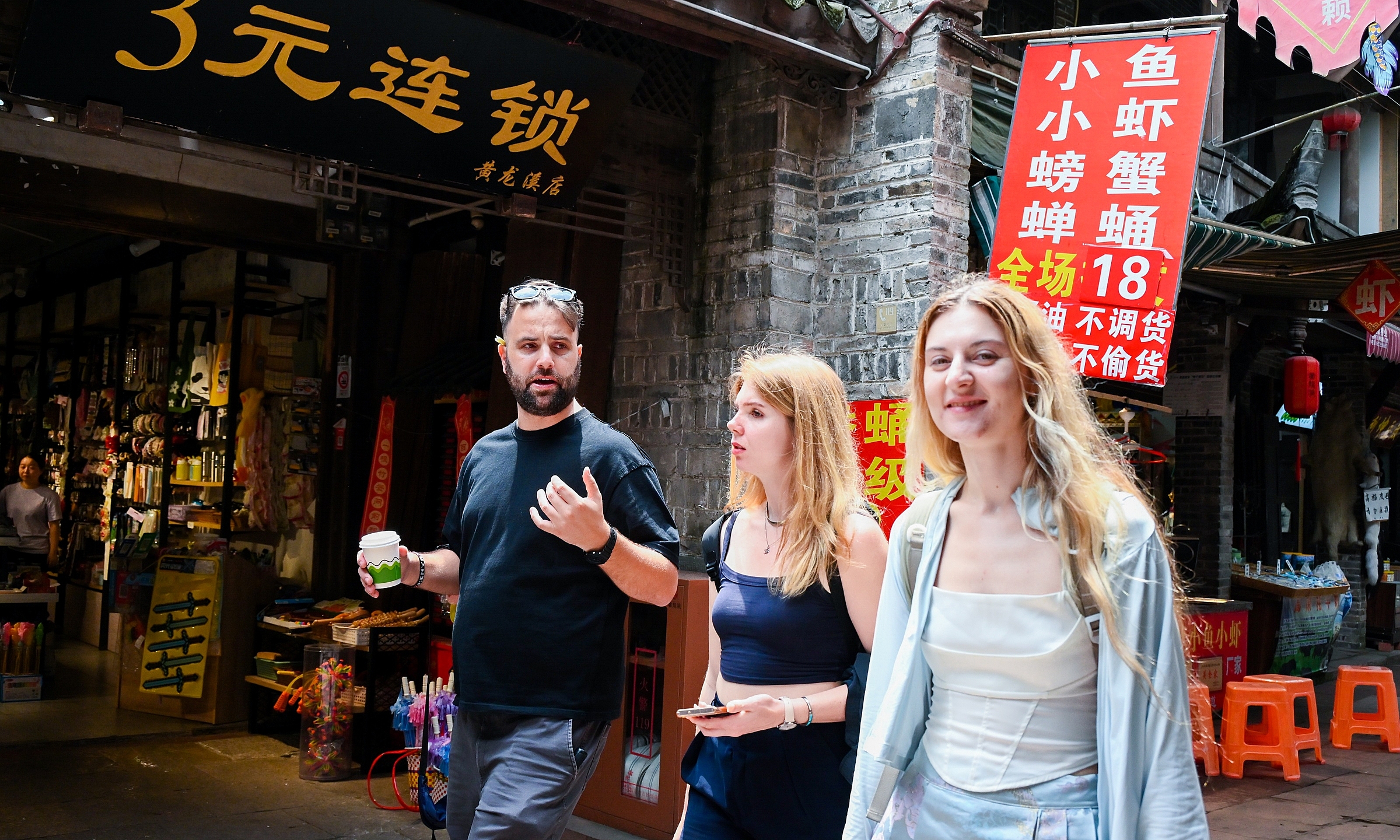After a recent 6-day trip to Shanghai, Chengdu, and Jiuzhaigou, Phuong Hoa (Hanoi) said that traveling in China was easier than she had expected. The visa, payment, and language barriers that her friends experienced before Covid-19 are gone.
"I only needed my ID card and a portrait photo for the visa. While traveling, I only needed my phone and passport to visit sites and shop via apps, from translation and ride-hailing to payments," Hoa said.
According to the World Travel & Tourism Council (WTTC), in 2024, the tourism sector contributed 1,670 billion USD (12,000 billion CNY) to China's economy, a 23% increase compared to 2023, creating over 82 million jobs. Domestic tourists accounted for 85% of total spending (819.4 billion USD), but the international tourist segment is the growth highlight.
"Despite some challenges in 2024 with an uneven recovery, international tourist spending has surpassed pre-pandemic levels," said Julia Simpson, WTTC President & CEO. Accordingly, spending from international tourists reached nearly 139 billion USD, 66% and 10% higher than in 2023 and before Covid-19, respectively.
In Quarter I of this year, the Ministry of Culture and Tourism of China reported that international visitors continued to increase by 19.6% compared to the same period, reaching over 35 million. What has attracted international tourists to China, encouraging them to spend hundreds of billions of USD? According to managers and businesses, it's the combination of open and convenient policies, technological strength, and abundant natural and cultural resources.
China has mutual visa exemption agreements with 25 countries and unilateral agreements with 38 countries. At the same time, it has extended the visa-free transit period to 240 hours for visitors from 54 countries. The results of this policy are clear, with over 70% of the total 9.2 million foreign visitors in the first 3 months of the year entering under visa-free policies, according to the immigration authorities.
During the recent International Labor Day holiday alone, approximately 380,000 foreigners entered under visa agreements, a 72.7% increase. As a result, during the 3-day holiday, mobile payment giant Alipay reported a 180% increase in tourist spending.
Previously, since mid-2023, international tourists have been able to open Alipay and Weixin Pay e-wallets using their passports and link their credit cards. Cities like Beijing have gone further with all-in-one cards, allowing tourists to pay for public transport and entrance tickets to attractions. "I exchanged 1,000 CNY in advance in case I couldn't use e-wallets, but I didn't have a chance to use cash," Hoa said.
She was also encouraged to shop more thanks to the instant tax refund policy at stores. China has also lowered the minimum purchase threshold for refunds, raised the cash refund ceiling, and expanded the range of applicable products.
Speaking on Xinhua's recent "China Economic Roundtable" program, Liu Jia from the National Immigration Administration said that foreign tourists have boosted spending on hotels and retail, contributing to the growth of service trade and investment.
Julia Simpson from WTTC assessed that the on-site tax refunds and expanded visa-free policies demonstrate a "smart strategy with a global vision." "This is long-term thinking focused on competitiveness, visitor experience, and restoring China's position as a leading global destination," she observed.
 |
A female tourist takes a photo with a panda statue in Chengdu, Sichuan in May. Photo: Trip |
A female tourist takes a photo with a panda statue in Chengdu, Sichuan in May. Photo: Trip
Many localities have capitalized on these policies, combined with further innovations, from facilitating language and payment to applying artificial intelligence (AI) technology. Some places like Guizhou and Shanghai have launched their own AI assistants. In Guizhou, tourists can chat with "Huang Xiaoxi," a virtual character dressed in local ethnic attire, for itinerary assistance and ordering local specialties with a single click.
Meanwhile, Shanghai launched the "Hu Xiaoyu" system, which connects real-time data with information from authorities and businesses, ranging from tourist traffic at attractions, traffic conditions, parking lots, to even restroom locations.
To be more foreigner-friendly, Shanghai has also established additional tourist information centers, multilingual signage, and multi-channel payment systems accepting international cards at popular spots. Connie Cheng, Deputy Director of the Shanghai Municipal Administration of Culture and Tourism, said that the city welcomed 1.26 million international visitors in Quarter I, a 61.9% increase.
"Recent policy initiatives have driven this positive trend," he explained at the recent Envision 2025 Conference. On the Trip platform, service bookings in the city increased by 130% during the May Day holiday, ranking it as a top destination in China.
Throughout the country, especially in museums and historical sites, smart guide devices are becoming increasingly common. These wearable devices combine virtual reality (VR), augmented reality (AR), and 3D technology, allowing users to interact with artifacts, transform ancient paintings into animations, and even "talk" to people from the past. For instance, visitors to the Chengdu Museum (Sichuan) will have VR glasses for interactive support.
Combining policy, technology, and heritage is also the direction of the action plan to promote international tourism, which includes 20 measures in 8 priority areas launched by Sichuan province in March, according to Vice Governor Hu Yun. These include facilitating visas, international transportation, payments, upgrading infrastructure, and service quality.
In Quarter I, the "home of pandas," known for its spicy hot pot and the "paradise on earth" Jiuzhaigou, welcomed 522,400 international tourists, an increase of nearly 63%. "All major scenic spots have experienced comprehensive growth in international tourist numbers," Hu Yun said at the "Chengdu Envision Night" event on 28/5.
 |
Tourists in Sichuan on 29/5. Photo: Trip |
Tourists in Sichuan on 29/5. Photo: Trip
Businesses in the industry also recognize the opportunity to refresh the appeal of destinations. Late last month, James Liang, Co-founder and Chairman of Trip.com Group, announced a 100 million USD Tourism Innovation Fund to invest in creative ideas such as digital festivals and the application of artificial intelligence (AI) in marketing and customer care.
Trip is a major Chinese travel company with a market capitalization of nearly 40 billion USD. In Quarter I/2025, the company's net revenue reached 13.8 billion CNY (approximately 1.9 billion USD), up 16% year-on-year and 9% quarter-on-quarter. EBITDA profit reached 4.2 billion CNY (584 million USD), up from 4 billion in the same period and 3 billion CNY in the previous quarter.
Trip CEO Jane Sun believes that this year, the group is entering a period of strong growth thanks to its global partner network and continuous investment strategy in technology. For example, AI tools are central to the strategy, supporting customers from planning and personalized itineraries to after-sales care. The virtual assistant TripGenie has helped increase average usage time by 50%, while the chatbot handles over 80% of after-sales requests.
According to Jane Sun, tourism remains a top priority for global consumers, and the industry will continue to grow faster than the overall economy. "With exciting opportunities ahead, we will continue to innovate," she said.
WTTC assesses that China's strength lies not only in domestic tourism. The targeted focus on restarting the international market, investing in infrastructure, easing visa policies, and global branding is driving a broader recovery, laying the foundation for inclusive and sustainable growth.
"All signs indicate that China's travel and tourism industry is on the right track," said Julia Simpson. The WTTC President predicts that international tourist spending in China will continue to be "very positive" this year.
Phien An












